Fundamentals of the art of Ikebany: Principles of dividing flower compositions on styles, traditional arrangements. Features of the placement of Ikebany in the interior.
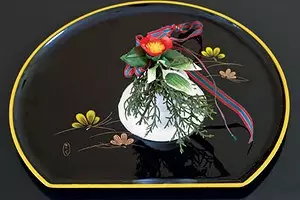
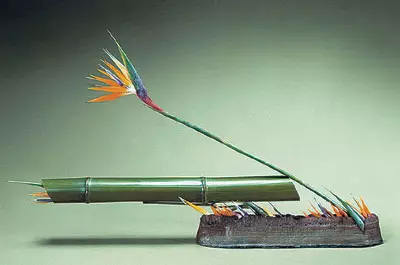
Avant-garde, bold Ikebana Sognce School, built on very strong horizontal lines of vase and bamboo stem. Flower of shooting tells her movement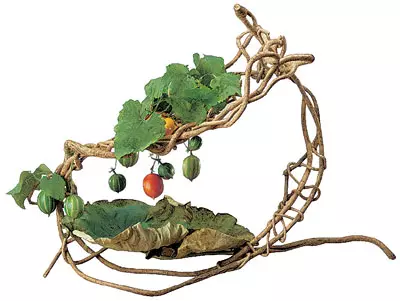
Autumn arrangement from Kiwi's vine, dry lotus leaves and exotic miniature pumpkin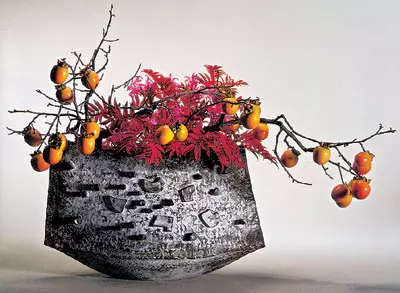
Ripe fruits of persimmon and bright leaves of Ryabina met in another autumn composition. School work Sogtse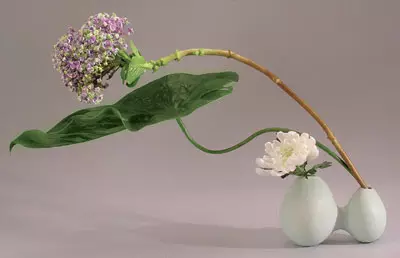
Strict rules of trimming and laying of plant material does not exist. You can use intentionally dried leaves, stalks, fruits or flowers, but you can not faded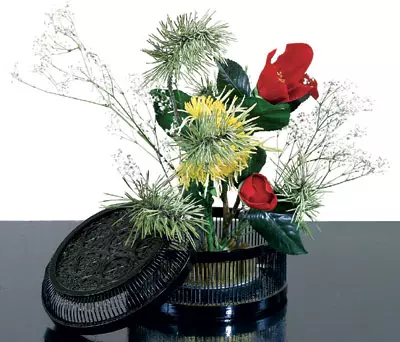
Composition of the school Ikenobo. Plants are fixed on Kenzan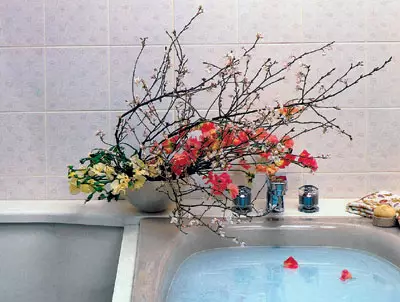
Spring Ikebana in the style of Moriban. Energetic curved branches contrast with delicate flowers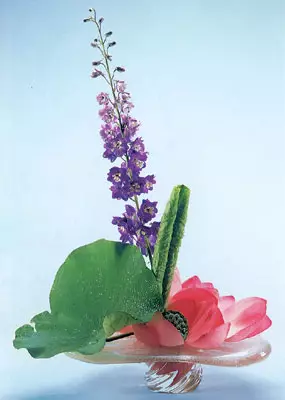
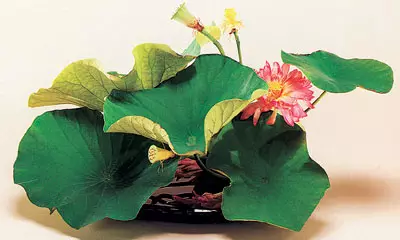
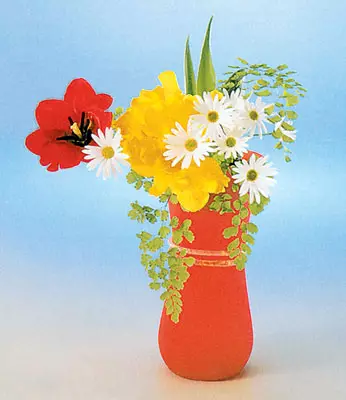
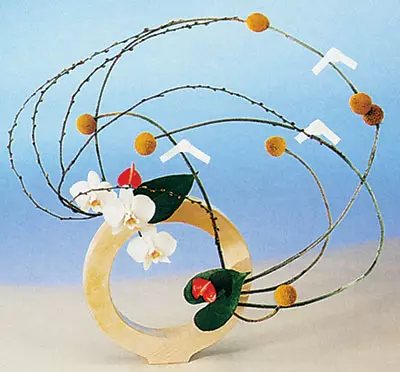
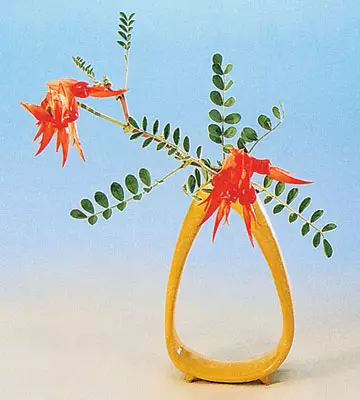
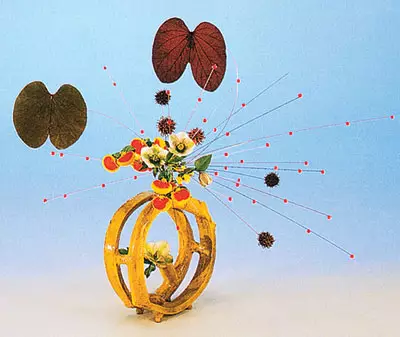
In the free compositions of the school, Ikenobo combines different materials and vegetable, and artificial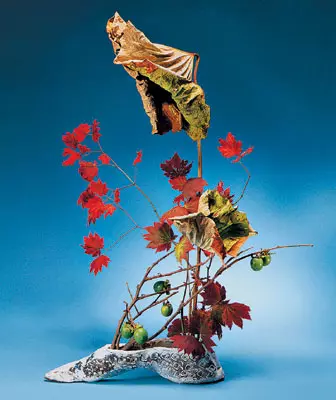
Improvise in choosing a vessel. Use empty bottles, rains for milk, baskets for vegetables - whatever
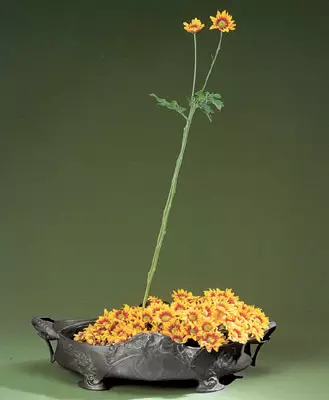
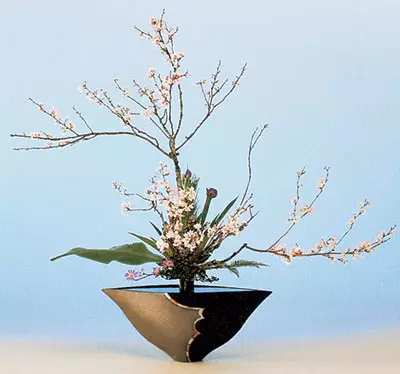
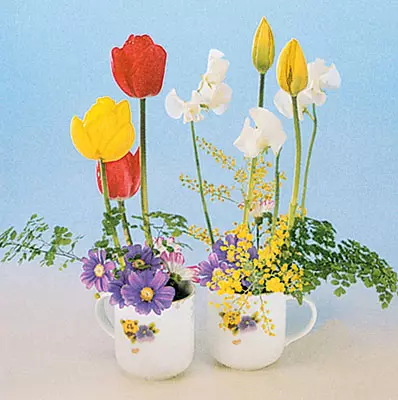
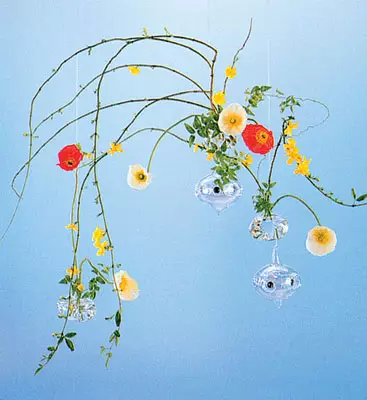
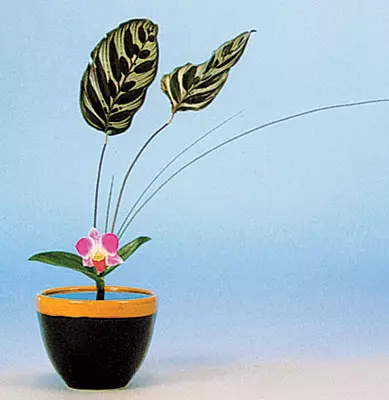
Dzyuka- style of free expression of the artist's feelings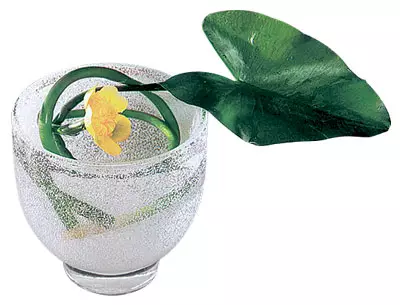
Miniature Ikebana is one of the innovations of the SEHETSA School. Flowers put in tiny vases, caskets, cups and even shells of nuts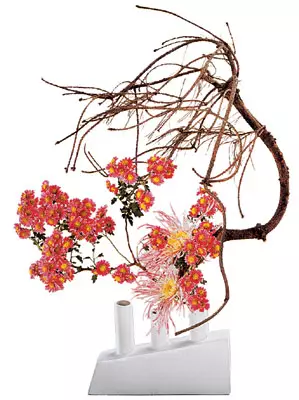
Extra branches and leaves are cut off by a secateur. It helps to identify the nature of the colors.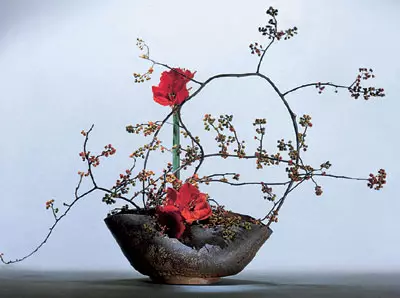
Line, color and mass- Here are three components through which Ikebana is perceived
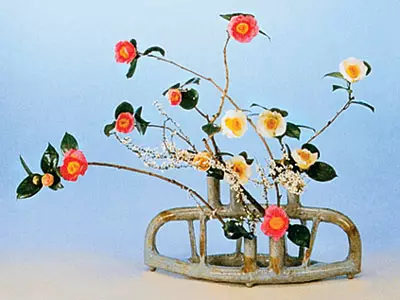
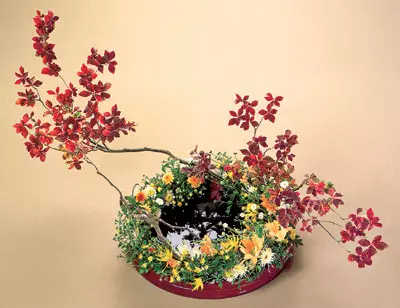
Modern arrangements are lush and bulk, they can be admired from all sides. Place them in the interior need to consider the nature of lighting and background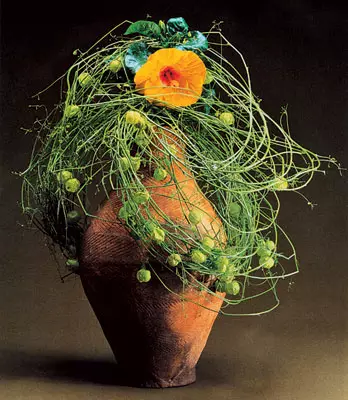
"The compositions of the Sogets school is inherent in traffic. Looking at them, the viewer is experiencing such a living on them, inside, Something Survive shelter," said Sofa Tassigahara. - If you have a feeling of conversation next to Ikebana, it means that you are standing before wonderful work "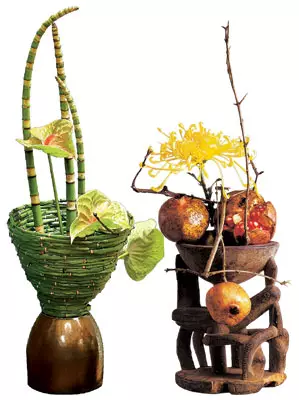
Completely unexpected combinations of vessels and plants or even fruits and berries may be harmonious
Exactly flowers, their serenetenderness restores everything in us
decreasing confidence in the world ...
Okavera Tensin. Book about tea
The color of the colors helps people better understand each other and express all the beauty of nature, such a thin and changeable, - Japanese Masters of Ikebany say.
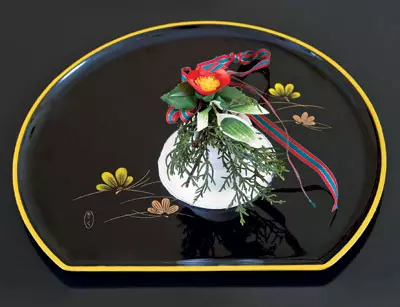
The centuries-old history of the arrangement of flowers in Japan serves as confirming that styles were born to each era and such compositions were created that were in harmony with the lifestyle, the businesses and traditions of their time, beginning to study the art of Ikebany, usually acquainted with one wise proverb. She tells meant that the Master of the Tea Ceremony rice was once in Japan, the garden of which was famous for the whole country with the flowers of the surcials and was so beautiful that even the ruling Sogun decided to visit him at that time. But, having appeared at Rica in the appointed morning, the ruler was surprised to find that all the flowers were cut off and only in the tea ceremony room stood Ikebana from a single stem of the surcials. The wizard sacrificed all the flowers of his garden to through one, the best, show their beauty. This parable reveals the essence of the miser expressiveness of the Ikebana: transfer the whole depth and variety of nature through one sheet, through one flower.
The Japanese word "Ikebana" was formed by two hieroglyphs: "IKE", which means "life", and "Khan" - "flower". Their combination is usually translated as "Flowers who live" or "live flowers". Of all the arts of Icaban closer to the sculpture, but only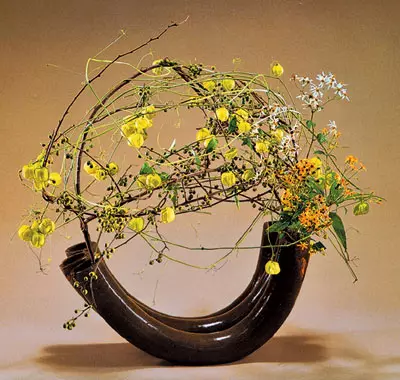
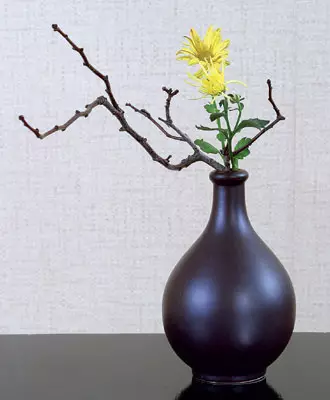
Ikebana is a meeting. Flower and branches. Plants and vessels. Nature and man. The Japanese believe that each of these meetings is not accidental and is predetermined by fate. Contemplative and thoughtful attitude towards life helps the master to open the beauty of myracto can do Ikebana? Anyone who knows how to feel thin and perceive the beauty and knowing the laws of designing vegetable material. These canons are not so simple, and they need to study them under the guidance of an experienced master. Several lessons here could not do, the years go to training: Ikebana - a lesson for patient. His story begins with the VIIV. - Since the time when Buddhism penetrates on the Japanese Islands, and along with him and tradition decorate the temples with flowers. About the XIV-XV centuries. Ikebana took shape as art and separated from religion, and CXVIIV. She began to engage not only men, but also women. The intersections of the arrangement are transmitted from the master to students, and the most intimate secrets it opens only the chosen, most persistent and patient.
Families with Ikebany are familiar not so long ago, but for several decades we have the branches of Japanese schools, where anyone can learn; The open lessons of masters from Japan are constantly held and exhibitions are arranged. If you yourself are not ready for a long and painstaking immersion in the world of Ikebany, order compositions from professionals - specialists work in many floral firms.
On modern trends
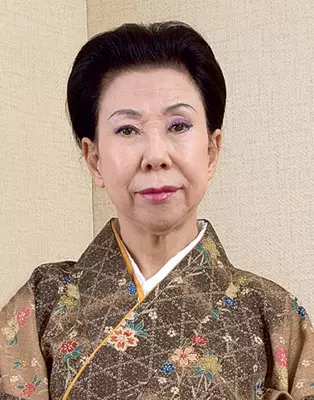
Today, much changes in the art of ikebany. The tradition of the indispensable placement of compositions in the niche of the toconom is derived. After World War II, American and European style came to Japanese houses. Tokyo Center was built up with high buildings, small apartments in them. Therefore, Ikebana has on TVs, cabinets and tables. New modern vessels appeared. Avota customs of the use of certain plants at different times of the year and on holidays are still observed. February in Japan-month of daffodils; On the day of memory in August, the compositions are made of lotus; September 9 - Holiday Chrysanthemum ... For the New Year's arrangement, traditional pine, bamboo and plum branches; It is necessary for it and a festive combination of white, green and red.
Icaban classes require a lot of time, and the plants of the road. Therefore, in Japan, the art of the arrangement of flowers today is mostly elderly. Acrosbe the professor of our school came to Russia, he was surprised and rejoiced that my students are so young.
Styles of Ikebany
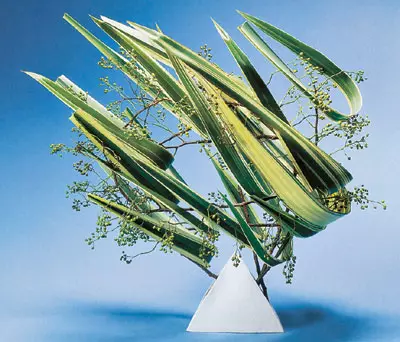
Monochrome composition from the leaves of New Zealand flax. Here as if the wind blows, and the viewer feels his breathing tutorial on Ikebane contains schematic drawings that explain the subtleties of creating compositions of different styles, step by step opens the student the laws of the arrangement art. Even for understanding such schemes requires certain skills. But the common features of each style can be described in just a few words. Of course, it is unlikely to allow you to make a caboan on your own, but will help learn how to comprehend the meaning of works of masters.
The opposite fission of styled compositions lie the principles of the location of the main elements in space and the choice of the vessel. The main branches can be from two to nine, but most often there are three of them, and in Ikebane, they symbolically designate three starts: the sky (syn), a person (SE) and the Earth (this element is called differently: Tai or Hikae). The branch, symbolizing the sky, is the longest, and personification of the earth is the shortest.
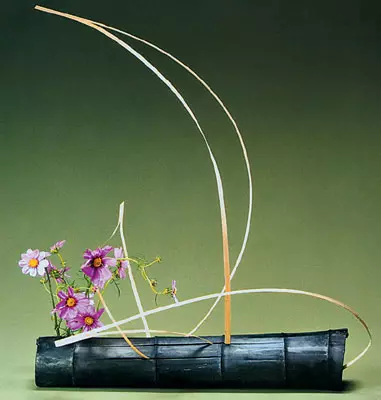
This work of art can only create an emotionally rich man with an exacerbated sense of perception of the naturally of all stylist (translated from the Japanese-"set flowers"). The basis of the vertical composition of Rickka, as a rule, is a pine or plum branch. It symbolizes the sky, and the remaining eight elements are located around it. In total, they are nine in Rickka, together they form the sphere. This is the most difficult style design, embodying the perfect image of the world. This arrangement is very monumental: it sometimes reaches 1.5m, in width, 1m. The massive compositions of Rickka in the past were decorated with temples, and then castles of Japanese aristocrats. Another vintage style, revealing the natural beauty of plants. Major elements in the sample three; Vases can be both high and low.
Of the three main elements, the compositions of two very popular styrees and Moriban are consisting of today. The principle of laying plants in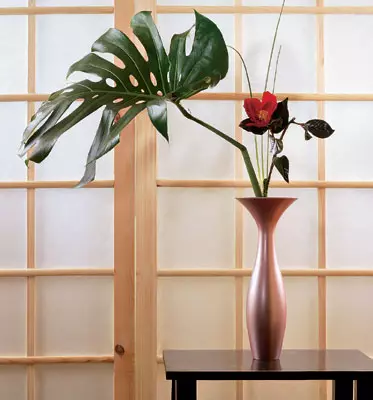
The art of Ikebans extremely concisely, through one flower it expresses the beauty of the whole nature of the compositions of the height (translated - "flowers abandoned in water") at first glance it is very simple: the colors will probably be careless, accidentally placed in a vase. But these ease and ease are only visible. The vessel is chosen high, with a narrow throat. The style of Heather reveals the beauty of the line of the branch or flower stem. Moriban - arrangement of several types of colors in a wide flat vase. Plants do not concern the walls of the vessel, but rising directly from the water. The arrangement form is free, special attention is paid to the variety of colors. The composition often mimics the floral cleaner or a river creek, reflected in the water mirror. The main task of Moriban - transmit the beauty of the landscape.
Relying on the basic principles of expressiveness, artists are creating in free style. It does not limit the masters in the choice of plants and blood vessels is the style of a relaxed expression, where the vase and vegetable material are often connected in one.
Schools Ikebany
In Japan, today there are several hundred schools of Ikebany. The most popular - Ikenobo, Ohara and Sogets. For more than ten years, branches of two of them - Ikenobo and Sogets have been opened for more than ten years.
Ikenobo ("Hut at the Pond") - the oldest of all schools: it appeared in the middle of the XVV. Today, it is also leading the 45th presidential master Sen Hey Ikenobo. This school is the keeper of the centuries-old traditions of Ikebany, its canons are the most stringent. Only in Ikenobo, the classic compositions of Rickka and the SEK are still constituted. But at the same time, Ikenobo continues to develop and makes changes to existing styles, adopts new recently appeared. It is only free (IKenobo is called "Dzyiuk"), allowing the master not only to demonstrate his art, but also more inseparably show feelings and emotions.
Sogetsa ("Grass and Moon") - one of the youngest schools, originated in 1927. Under the influence of avant-garde currents in visual art. Her founder of the Sofa of Tassigahara, who was friends with Salvador, Dali and Picasso, believed that any art should develop in accordance with the changing stands, the views and ski of society. School SEHETSU allows the master to use not only colors, branches and leaves of plants, but also by any materials and objects of everyday use. Metal, plastic, glass, paper, polyethylene, wire, rope, even used package from under milk or old frying pan ... Finding ourselves as part of ketabans, they cease to perform household functions and begin to express art ideas. Putting the idea of its own: in plastic flexibility, in metal shine and rigidity. Compared to natural, such materials are "aggressive" and less harmonious, but it is their combination with plants that helps to soften the environment in which a modern person lives.
Seasons and holidays
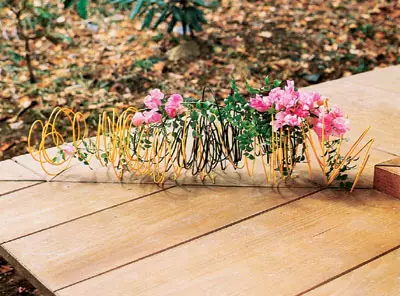
Modern compositions of the Sognce school can be put not only in the house, but also in the garden - they fill the landscape with new colors and emotions live together with nature and man, so Ikebana should create a feeling of continuously changing being, to live itself. Riding flowers, the master is necessarily sharing with them his mood. In indifference, he creates a calm and lyrical composition, in a fit of joy-bright, ringing. The guests of the guests will put something not very personal, and preparing for a visit of a friend-Estet, will fully demonstrate their art.
Looking at the classic Ikebana, usually you can immediately determine what time of year is it. Symbol of spring- Of course, Sakura. But it is very difficult to make it very difficult to compose to Ikebana: After all, the petals quickly appear, therefore this plant and became the personification of a samurai, ready to give life to the emperor. Isvs of Sakura create compositions, and in their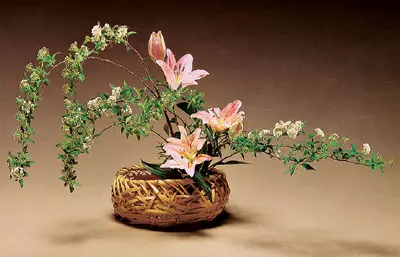
Moriban from Lily and Spirea in a traditional Japanese vessel - in a basket. School work Sogetsu Lower part always place the brightest bloom flowers, and upstairs. As in nature! In spring arrangements, branches with young and gentle shoots, buds and, possibly, several already discontinued flowers are used. Traditional for this season, flowering branches of fruit trees apricot, plums, peach, almond, cherry and quince; Flower, freesia, irises, tulips and peonies.
In the spring, two national holidays celebrate in Japan. 3Mart, on the day of girls, in every house where there is a daughter, arranged on a special stand of dolls, richly dressed. They are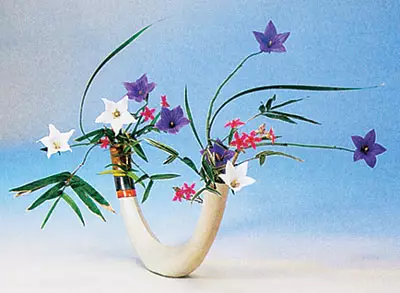
According to Sieney Ikenobo, the disciple is very important to understand that "in Ikebane, the flowers are not static, they constantly change their expression, and we are watching their lives" must bring happiness. Wakebane use pink (flowering branches peach - symbol of tenderness) and yellow (tangerine flowers) paints. Double boys, 5m, set the compositions from the iris - these flowers personify the courage. Their leaves resemble swords with their shape. Therefore, according to the Japanese, the leaves of the iris (those of them that symbolize a person and land) should be located to the viewer with their record, and not an edge, that is, with the edge. Summer compositions lush and abundant. In large quantities, field and meadow grass and flowers are used, as well as a lot of greenery. Autumn- The time of the bright colors of the leaf, the time of chrysanthemums and a basket of sunflower, ripe vegetables and fruits. When the compositions are made of maple, the laws of nature are necessarily observed: the highest branch is red, the average is yellow, the lowest is green. At the beginning of the autumn, on the day of admirement the moon (in Japan, this is a national holiday!), Arrangement is created, with its outlines of recubuses. Finally, winter materials - bare branches of deciduous trees or evergreen plants, first of all pines.
Designing ikebany
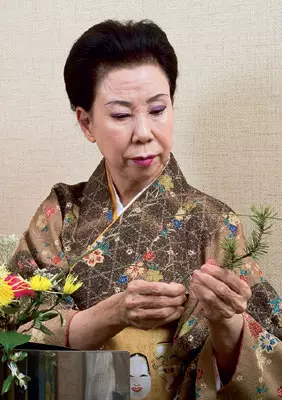
The selected style determines both the main proportions of the compositions of the composition, the length and the inclination of the branches, the density of filling the space, the ratio of plants with the shape and color of the vessel. If the vase is low and wide, there are special devices for the installation of flower-kenzane (metal plates with multiple needles). They can have a different form (round, oval, rectangular) and sizes. The branches are placed between Cenzan's needles or heating on them. Vasey vases with a narrow neck Flowers rely on the edge of the vessel and calyan does not apply. Working with soft stems, often use wires, it helps support them or bend in an interesting way.
Sometimes Ikebana can live only an hour (arrangement from Ipomey), sometimes a few hours (compositions that accompany the tea ceremony) or even a week. "Long-livers" require care. Wood stems (lilac, viburnum) are pre-split and placed in hot water. If there are species with hollow stems in Ikeban (hypadastrum, calla), they are sure to fill with water. Fading plants are replaced with fresh, for which it sometimes has to completely sort out the oscaban. Water in the vessel is constantly updated; To extend the life of cut colors, special means are used.
Life in the interior
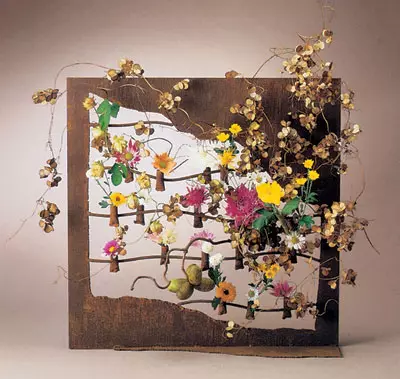
An unusual vase made of coarse iron, resembles a tonal mill, and flowers and dried liana-graceful music passes. Very musical composite by Ikebana, the master not only works with vegetable material and picks up a vessel of a certain shape, color and size to it. He necessarily sees and takes into account everything that will surround the composition - background, items that will be nearby, the overall style of the interior, the nature of lighting.
For centuries, a tradition was formed to place ikeban in the very festive and honorable place of the Japanese house-niche of the toconom. It is hanging a scroll with calligraphically written sketching or painting, and on both sides there are compositions from flowers and stones. All of them one way or another convey the state of nature and the mood of the owners of the house. Ikebana, located in the toconom, is overlooked on the one hand and therefore has distinctly pronounced facial and rear parts. However, the architectural layout of modern apartments is very different from the traditional Japanese interior.
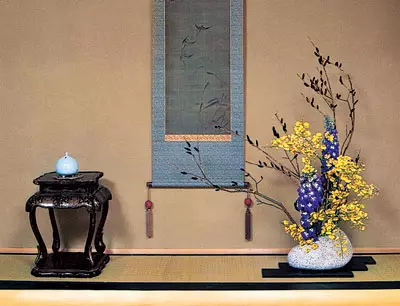
Toconoma - front niche, which is there today in a traditional Japanese house. Icaban, built for toconom, has a clearly pronounced facial and the back of the other, is increasingly raised so that it is overlooked from all sides, it is more voluminous and multifaceted than before. The compositions are placed in residential rooms, and in the hallways, and even in the bathrooms. For located at high altitude or hanging, it is better to use curly plants for low-reprehension. The arrangements on the dinner table should not be too high and massive - they will interfere with communication. These are often suspended in a light bamboo vessel ikeban, the main part of which is the elegant falling branch (liana or the willow branch), the colors are very small. Such a composition welcomes everyone in the house and serves as the wishes of good.
The correctly selected environment will bete the beauty of the flower and lines, will strengthen the sound of certain tones, highlights the individual, most expressive components. Horizontal background (tablecloth on the table, coating rack or shelf) it is better to choose a neutral color, not blunt. The vase can be installed on the stand: a special black or red-drier skid, wood, cardboard, paper or napkin.
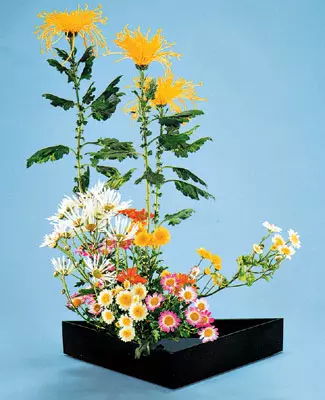
Before proceeding to the formulation of Ikebany, mentally talk to the cooked plants. Carefully consider each flower and branch, find the most expressive model and the same composition can produce an absolutely different impression depending on the nature of the lighting. The direction of light, its intensity and color tonality - all this must be considered before putting the oscabane. If it is placed opposite the window, especially overlooking the south, the viewer will not see bright colors, but will be able to enjoy the contour of the arrangement. The so-called silhouette works are appropriate here, emphasizing a beautiful graphic pattern of branches. Instead of colors, it is better to use large elongated leaves, burglars of herbs, sobs of Rhoze. Ikebana, illuminated by natural light from the window, will change its appearance during the day and look in different way into clear sunny and cloudy weather. If there are multi-colored lamps in the house, then with their help you can decorate the background of the composition. In the early time, the wizard began to apply the backlight of the oscaban from the inside.
By installing Ikebana in the interior, you should always remember the perspective from which it will be considered. From that that all parts of the composition interact with each other and that the space between the colors is no less expressive than the vegetable material itself.
The editorial office thanks the president of the branch of the Ikenobo Institute in Russia and the CIS countries Mr. Midori Yamada, the center of Ikebana Ikenobo and the director of the Moscow branch Sogetsu O. Yu.Fomichev for help in preparing the material, as well as Japanese magazines "Ikerbana Sogets" and "Ikebana Ikenobo" for the provided photographic materials .
